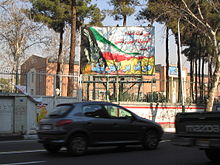- Embassy of the United States, Tehran
-
The defaced Great Seal of the United States in 2004

The United States Embassy in Tehran is a building located in Tehran, Iran.
Contents
History
The embassy was designed in 1948 by the architect Ides van der Gracht. It was a long, low two-story brick building, similar to American high schools built in the 1930s and '40s. For this reason, the building was nicknamed "Henderson High" by the embassy staff, referring to Loy W. Henderson, who became America's ambassador to Iran just after construction was completed in 1951.[1]
The US diplomatic mission has been defunct since the Iran hostage crisis of 1979. Since then, the United States government has been represented in Iran by the United States Interests Section of the Embassy of Switzerland in Tehran. The name currently given to the compound by many Iranians is variously translated as "espionage den," "den of espionage", and "nest of spies".[2]
After the fall of the embassy, Revolutionary Guard used it as a training center. The brick walls that form the perimeter (the embassy grounds are the size of a city block) feature a number of anti-American murals commissioned by the government of Iran. The site has also housed a bookstore and a museum (though both are closed to foreigners and the general Iranian public, though exceptions do exist). The Great Seal of the United States is badly damaged but still visible at the entryway.
The Muslim Student Followers of the Imam's Line published documents seized in the embassy (including painstakingly reconstructed shredded documents) in a series of books called "Documents from the US Espionage Den" (Persian: اسناد لانه جاسوسی امریكا). These books included telegrams, correspondence, and reports from the United States Department of State and Central Intelligence Agency, some of which remain classified to this day.
See also
- Iran hostage crisis
- Iran – United States relations
- United States Ambassador to Iran
- Iranian Embassy in Washington (Iran does not currently have an embassy in the United States, but its interests are handled through the Interests Section of the Islamic Republic of Iran in the United States in the Pakistani embassy.)
References
- ^ The architecture of diplomacy: building America's embassies ADST-DACOR diplomats and diplomacy series. Jane C. Loeffler. Publisher Princeton Architectural Press, 1998. ISBN 1-56898-138-4 pp.56
- ^ Federation of American Scientists on the Espionage Den
External links
- The Memory Hole hosts a gallery of photographs taken from inside the US Embassy during the crisis.
- The Memory Hole 400 Pages of Still-Classified CIA and State Dept Documents Seized From the US Embassy in Tehran.
- Contemporary photograph of the embassy gates (on flickr)
- Embassy of Switzerland - Foreign Interests Section
- U.S. Department of State page for Iran
Coordinates: 35°42′29″N 51°25′27″E / 35.70806°N 51.42417°E
 List of diplomatic missions of the United States
List of diplomatic missions of the United StatesAfrica Juba
Americas Havana · Ottawa
Asia Europe Athens · Berlin · Chişinău · Dublin · Frankfurt · Hamburg · Munich · London · Moscow · Oslo · Paris · Prague · Rome · Sarajevo · Thessaloniki · Tirana · Vatican · Vienna
Oceania Canberra · Wellington
Former Categories:- Buildings and structures of the Iranian Revolution
- Iran–United States relations
- Diplomatic missions of the United States
- Buildings and structures in Tehran
- Defunct diplomatic missions
- Iranian building and structure stubs
Wikimedia Foundation. 2010.


